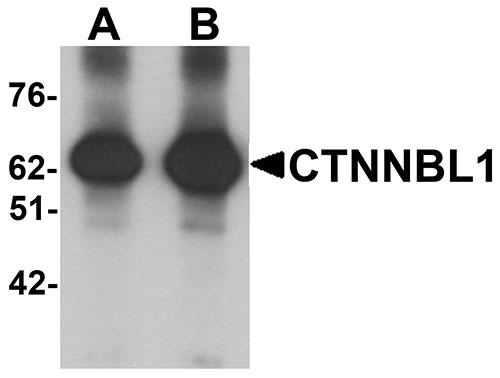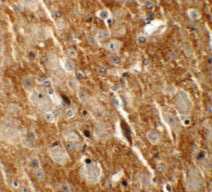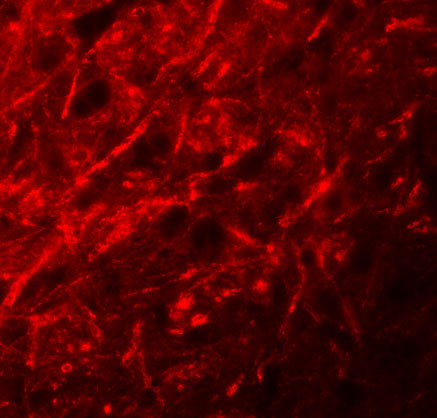CTTNBL1 Antibody
- SPECIFICATION
- CITATIONS
- PROTOCOLS
- BACKGROUND

Application
| WB, IHC-P, IF, E |
|---|---|
| Primary Accession | Q8WYA6 |
| Other Accession | NP_110517, 18644734 |
| Reactivity | Human, Mouse, Rat |
| Host | Rabbit |
| Clonality | Polyclonal |
| Isotype | IgG |
| Calculated MW | 65173 Da |
| Application Notes | CTTNBL1 antibody can be used for detection of CTTNBL1 by Western blot at 1 and 2 µg/mL. Antibody can also be used for immunohistochemistry starting at 5 µg/mL. For immunofluorescence start at 20 µg/mL. |
| Gene ID | 56259 |
|---|---|
| Target/Specificity | CTNNBL1; CTNNBL1 antibody is predicted to not cross-react with other catenin family members. At least four isoforms of CTNNBL1 are known to exist; this antibody will detect all but isoform b. |
| Reconstitution & Storage | CTTNBL1 antibody can be stored at 4℃ for three months and -20℃, stable for up to one year. As with all antibodies care should be taken to avoid repeated freeze thaw cycles. Antibodies should not be exposed to prolonged high temperatures. |
| Precautions | CTTNBL1 Antibody is for research use only and not for use in diagnostic or therapeutic procedures. |
| Name | CTNNBL1 |
|---|---|
| Synonyms | C20orf33 |
| Function | Component of the PRP19-CDC5L complex that forms an integral part of the spliceosome and is required for activating pre-mRNA splicing. Participates in AID/AICDA-mediated somatic hypermutation (SHM) and class-switch recombination (CSR), 2 processes resulting in the production of high-affinity, mutated isotype-switched antibodies (PubMed:32484799). |
| Cellular Location | [Isoform 1]: Nucleus. |
| Tissue Location | Widely expressed with highest levels in skeletal muscle, placenta, heart, spleen, testis and thyroid |

Thousands of laboratories across the world have published research that depended on the performance of antibodies from Abcepta to advance their research. Check out links to articles that cite our products in major peer-reviewed journals, organized by research category.
info@abcepta.com, and receive a free "I Love Antibodies" mug.
Provided below are standard protocols that you may find useful for product applications.
Background
CTTNBL1 Antibody: The Beta-catenin-like protein 1 (CTNNBL1) contains an acidic domain, a putative bipartite nuclear localization signal, a nuclear export signal, a leucine-isoleucine zipper, and phosphorylation motifs, as well as Armadillo/beta-catenin-like repeats. Transient expression of CTNNBL1 resulted in translocation to the nucleus and apoptosis, suggesting it may be involved in the apoptotic pathway. CTNNBL1 interacts with the Prp19 complex of the spliceosome and the Ig class switching enzyme activation-induced deaminase (AID) and had been suggested to play a role in antibody-diversification and class switching, but recent studies have shown CTNNBL1 to be dispensable for Ig class switch recombination. Other studies have identified CTTNBL1 as a novel gene for obesity.
References
Jabbour L, Welter JF, Kollar, et al. Sequence, gene structure, and expression pattern of CTNNBL1, a minor-class intron-containing gene - evidence for a role in apoptosis. Genomics 2003; 81:292-303.
Conticello SG, Ganesh K, Xhu K, et al. Interaction between antibody-diversification enzyme AID and spliceosome-associated factor CTNNBL1. Mol. Cell 2008; 31:474-84.
Han L, Masani S, and Yu K. Cutting edge: CTNNBL1 is dispensable for Ig class switch recombination. J. Immunol. 2010; 185:1379-81.
Liu YJ, Liu XG, Wang L, et al. Genome-wide association scans identified CTNNBL1 as a novel gene for obesity. Hum. Mol. Genet. 2008; 17:1803-13.
If you have used an Abcepta product and would like to share how it has performed, please click on the "Submit Review" button and provide the requested information. Our staff will examine and post your review and contact you if needed.
If you have any additional inquiries please email technical services at tech@abcepta.com.













 Foundational characteristics of cancer include proliferation, angiogenesis, migration, evasion of apoptosis, and cellular immortality. Find key markers for these cellular processes and antibodies to detect them.
Foundational characteristics of cancer include proliferation, angiogenesis, migration, evasion of apoptosis, and cellular immortality. Find key markers for these cellular processes and antibodies to detect them. The SUMOplot™ Analysis Program predicts and scores sumoylation sites in your protein. SUMOylation is a post-translational modification involved in various cellular processes, such as nuclear-cytosolic transport, transcriptional regulation, apoptosis, protein stability, response to stress, and progression through the cell cycle.
The SUMOplot™ Analysis Program predicts and scores sumoylation sites in your protein. SUMOylation is a post-translational modification involved in various cellular processes, such as nuclear-cytosolic transport, transcriptional regulation, apoptosis, protein stability, response to stress, and progression through the cell cycle. The Autophagy Receptor Motif Plotter predicts and scores autophagy receptor binding sites in your protein. Identifying proteins connected to this pathway is critical to understanding the role of autophagy in physiological as well as pathological processes such as development, differentiation, neurodegenerative diseases, stress, infection, and cancer.
The Autophagy Receptor Motif Plotter predicts and scores autophagy receptor binding sites in your protein. Identifying proteins connected to this pathway is critical to understanding the role of autophagy in physiological as well as pathological processes such as development, differentiation, neurodegenerative diseases, stress, infection, and cancer.




